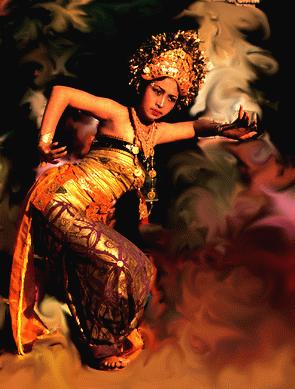|
Dance, music,
and the theater of wayang
are other forms of expression laden with religious connotations.
The Trance Dance, for example, is performed when a village
is suffering, say from an epidemic or bad harvest. The dance
is intended to appease the gods and goddesses, with the
hope that they will bless the village. Other dances also
manifest the great complexity of Balinese daily lives which
are never detached from their religious beliefs. Throughout
the year, you can regularly
find scheduled dance performances, especially the Balih-balihan
or entertainment dances.
Dances
Along with the Hindu religion, the Indian influence in
Balinese dances is also significant. Balinese strong identity
adapts these various influences with indigineous religion
of animism and folklore traditions, creating an expression
distinctively flavored by Balinese ethnicity.
Much like the training of gamelan orchestra players, dance
training begins when one is still very young. The teacher
will stand in front of the children and start dancing. The
children will follow her every movement. Once the teacher
feels that a child understands the basic sequence, she will
stand behind the child, and direct the child by holding
her wrists. Practicing with a gamelan orchestra will only
happen when the dance is considered to have entered the
student. The dancer must learn to fully express the character
that she is dancing for; self expression is not a known
concept.
Based on their religious functions, Balinese dances can
be categorized into three:
1. Wali (sacred) Dances
These dances are considered sacred, and must be performed
in the inner court of the temple.
- Rejang
Danced by females, Rejang dance is a procession of those
who have just barely learned to walk to those who can
barely walk, moving in a slow and stately fashion towards
the altar, twirling fans or lifting their sashes. Their
costumes range from a very simple attire to an elaborate
dress complete with headdress as you would likely find
in Tenganan.
- Baris
Literally means warrior formation. Baris is a warrior
dance usually danced by men. The movements are dramatic.
It is hard to distinguish whether it is the dancer that
follows the orchestra, or the other way around. You could
say that they both go off into their own dimensions, yet
at certain well-defined times meet to create an astounding
tapestry. The dancers wear elaborate head decoration,
from a gold-colored head band to leaves and strings of
cempaka blossoms. Variants of this dance are sometimes
danced by children and women. You can find this dance
performed in Sanur, Tabanan, and Ubud.
- Pendet
This dance is usually performed by married women, moving
in very dignified and elegant way to carry and present
offerings to the gods and the goddesses.
- Sang Hyang Dedari (Trance Dance)
This dance is normally performed to entertain the gods
and the goddesses to appease them or to ask for their
blessings. A bad harvest or an outburst of an illness
may warrant such a dance. The preparation for this dance
may take months, as prepubescent girls who have never
danced are trained to relax their mind to be able to get
into a trance state. Day after day they visit the priest
at the local temple to receive their lessons. When the
priest concludes that they are ready, and the time is
right, the dance will be performed in the court of the
temple. Dressed in elaborate attire and immersed in the
smoke of burning incense, the two young girls slowly dance
as the accompanying chant of the village women gradually
relax them to get into trance. The gods and the goddesses
will enter their bodies as they enter trance, and they
will dance with movements that they have not mastered
in their normal state. They may act and sound like a horse
or a monkey; at times, they end up dancing while balancing
their back on a piece of bamboo supported by two men on
both ends. When they collapse, the village women will
chant to ask the gods and the goddesses to peacefully
leave the bodies of the young girls. If they refuse, dancing
will continue until they agree, at which point the girls
will simply collapse.
- Barong
Barong is probably the most well known dance. It is also
another story-telling dance, narrating the fight between
good and evil. This dance is the classic example of Balinese
way of acting out mythology, resulting in myth and history
being blended into one reality. Wanna
know the story?
2. Bebali Dances
These dances are ceremonial, and usually performed in the
middle court of a temple. In the spectrum of sacred and
secular, these dances fall in the middle.
- Gambuh
Gambuh is a danced drama. It tells the courtly story of
a Javanese prince in his quest for a beautiful princess.
3. Balih-balihan Dances
These dances are often considered secular and entertaining.
They are performed in the outer court or even outside the
temple.
- Janger
Janger is performed by young girls. Peacock crown shaped
headwear made from intricately woven gold-colored, dried
coconut leaves rests gallantly on their heads. The girls
are open shouldered, dressed in a piece of cloth wrapped
around the chest, and a batik wrap on the waist down.
Most of the dances are performed sitting down, with highly
coordinated hand, shoulder, and eye movements.
- Kebyar
Kebyar is usually danced by two women with beautiful,
long, shiny black hair, accentuated at the top by a band
of cempaka blossoms. Fans on one hand, they move dramatically.
Feet are strongly grounded, and hands and feet move abruptly.
- Legong
The dance of legong tells a story. It is the most feminine
dance. It is usually danced by two females before they
reach puberty (in fact, they must retire by the time they
reach puberty).
- Kecak
Kecak is a spectacular dance usually performed at night,
surrounding a bonfire. The westerners called this dance
The Monkey Dance, for the movements may remind us of monkey's
movements. There can literally be one hundred or more
bare chested men, sitting down on the ground surrounding
the bonfire, led by a priest in the middle. The only music
to accompany them are the beats of their palms hitting
their chests, their thighs, or other parts of their bodies,
or their claps, rhythmically accompanied by shouting and
chanting.
The dancers move in unison, creating a spectacular choreographic
performance. Either hands stretched out, pulled in, rested
on the shoulder of the next person, or waists gyrated
left and right, etc.
Regularly
scheduled performances of these dances, especially the
Balih-balihan dances, can be found throughout the year.
|







